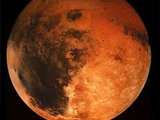Today.Az » Weird / Interesting » New mystery on Mars' forgotten plains
17 October 2011 [18:23] - Today.Az
 One of the supposedly best understood and least interesting landscapes on Mars is hiding something that could rewrite the planet's history. Or not. In fact, about all that is certain is that decades of assumptions regarding the wide, flat Hesperia Planum are not holding up very well under renewed scrutiny with higher-resolution, more recent spacecraft data.
One of the supposedly best understood and least interesting landscapes on Mars is hiding something that could rewrite the planet's history. Or not. In fact, about all that is certain is that decades of assumptions regarding the wide, flat Hesperia Planum are not holding up very well under renewed scrutiny with higher-resolution, more recent spacecraft data.
"Most scientists don't want to work on the flat things," noted
geologist Tracy Gregg of University at Buffalo, State University of New
York. So after early Mars scientists decided Hesperia Planum looked like
a lava-filled plain, no one really revisited the matter and the place
was used to exemplify something rather important: The base of a major
transitional period in the geologic time scale of Mars. The period is
aptly called the Hesperian and it is thought to have run from 3.7 to 3.1
billion years ago.
But when Gregg and her student Carolyn Roberts started looking at
this classic Martian lava plain with modern data sets, they ran into
trouble.
"There's a volcano in Hesperia Planum that not many people pay
attention to because it's very small," Gregg said. "As I started looking
closer at the broader region -- I can't find any other volcanic vents,
any flows. I just kept looking for evidence of lava flows. It's kind of
frustrating. There is nothing like that in the Hesperia Planum."
"A likely cause of this trouble is the thick dust that blankets
Hesperia Planum," she said. "It covers everywhere like a snowfall."
So she turned her attention to what could be discerned on Hesperia
Planum: about a dozen narrow, sinuous channels, called rilles, just a
few hundred meters wide and up to hundreds of kilometers long. These
rilles have no obvious sources or destinations and it is not at all
clear they are volcanic.
"The question I have is what made the channels," said Gregg. Was it
water, lava, or something else? "There are some lavas that can be
really, really runny. And both are liquids that run downhill." So either
is a possibility.
To begin to sort the matter out, Gregg and Roberts are now looking
for help on the Moon. Their preliminary findings are being presented at
the Annual Meeting of The Geological Society of America in Minneapolis.
"On the Moon we see these same kinds of features and we know that
water couldn't have formed them there," Gregg said. So they are in the
process of comparing channels on the Moon and Mars, using similar data
sets from different spacecraft, to see if that sheds any light on the
matter. She hopes to find evidence that will rule out water or lava on
Hesperia Planum.
"Everybody assumed these were huge lava flows," said Gregg. "But if
it turns out to be a lake deposit, it's a very different picture of what
Mars was doing at that time." It would also make Hesperia Planum a good
place to look for life, because water plus volcanic heat and minerals
is widely believed to be a winning combination for getting life started.
"The 'volcanic' part is an interpretation that's beginning to fall
apart," said Gregg. "What is holding up is that the Hesperian marks a
transition between the Noachian (a time of liquid water on the surface
and the formation of lots of impact craters) and the Amazonian (a drier,
colder Mars)."
She has found that other scientists are interested in her work
because of its possible implications on the Mars geological time scale.
Gregg is not worried that Mars history will need to be rewritten, but
she does suspect that Hesperia Planum is a lot more complicated than
people has long thought.
/Science Daily/
|